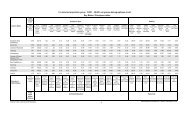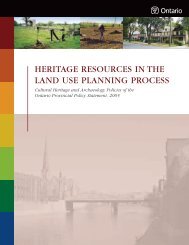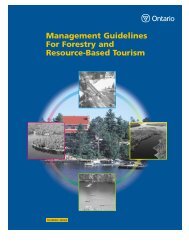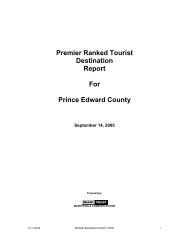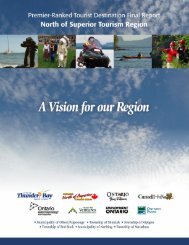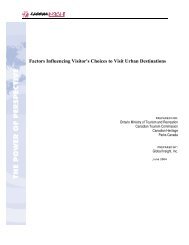Forest Operations on Crown Land - Ministry of Tourism
Forest Operations on Crown Land - Ministry of Tourism
Forest Operations on Crown Land - Ministry of Tourism
- No tags were found...
Create successful ePaper yourself
Turn your PDF publications into a flip-book with our unique Google optimized e-Paper software.
OverviewThis bulletin is intended to help c<strong>on</strong>sultant archaeologists as they follow the Standards andGuidelines for C<strong>on</strong>sultant Archaeologists (2011) to carry out archaeological assessments forforest management plans and mitigate impacts to archaeological sites during forestmanagement activities <strong>on</strong> <strong>Crown</strong> land.<str<strong>on</strong>g>Forest</str<strong>on</strong>g> resource licence holders are required to address a range <strong>of</strong> possible heritage impactswhen c<strong>on</strong>ducting forestry operati<strong>on</strong>s. This includes ensuring that the Ontario Heritage Act isfollowed so that registered archaeological sites are protected and the disturbance <strong>of</strong>unidentified archaeological sites as a result <strong>of</strong> forest operati<strong>on</strong>s is minimized.The Ontario Heritage Act sets out priorities, policies, and programs for the c<strong>on</strong>servati<strong>on</strong> <strong>of</strong>archaeological resources <strong>of</strong> cultural heritage value. It also provides for the licensing <strong>of</strong>individuals who wish to carry out archaeological fieldwork. The <strong>Ministry</strong> <strong>of</strong> <strong>Tourism</strong> andCulture’s Standards and Guidelines for C<strong>on</strong>sultant Archaeologists (2011) defines the practicesc<strong>on</strong>sultant archaeologists must follow when employed by a prop<strong>on</strong>ent to address thearchaeological c<strong>on</strong>servati<strong>on</strong> requirements set out in the Ontario Heritage Act.The Standards and Guidelines recognize certain unique features <strong>of</strong> archaeologicalassessments carried out in c<strong>on</strong>necti<strong>on</strong> with forest operati<strong>on</strong>s <strong>on</strong> <strong>Crown</strong> <strong>Land</strong>s. Thisbulletin expands <strong>on</strong> the Standards and Guidelines by outlining a process specific to forestoperati<strong>on</strong>s <strong>on</strong> <strong>Crown</strong> land that allows for the identificati<strong>on</strong> and subsequent avoidance andprotecti<strong>on</strong> <strong>of</strong> areas <strong>of</strong> archaeological potential and known archaeological sites withinforest management units <strong>on</strong> <strong>Crown</strong> land.As an additi<strong>on</strong>al source <strong>of</strong> informati<strong>on</strong>, the <strong>Ministry</strong> <strong>of</strong> <strong>Tourism</strong> and Culture’s draftbulletin Engaging Aboriginal Communities in Archaeology may be helpful to c<strong>on</strong>sultantarchaeologists working in forestry c<strong>on</strong>texts as it clarifies best practices for engagingAboriginal communities in the archaeological assessment process.Archaeological Assessments for <str<strong>on</strong>g>Forest</str<strong>on</strong>g> <str<strong>on</strong>g>Operati<strong>on</strong>s</str<strong>on</strong>g> <strong>on</strong> <strong>Crown</strong> <strong>Land</strong>s | 1



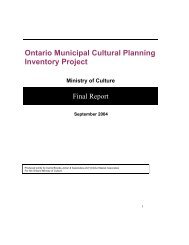
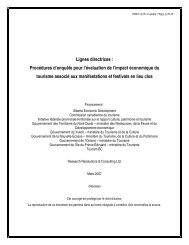
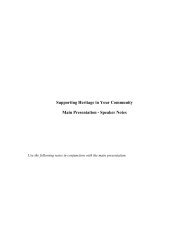
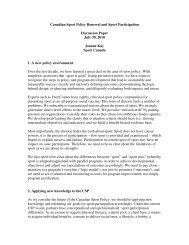
![THIS AGREEMENT made this [date], between [name of owner] (the ...](https://img.yumpu.com/49827605/1/158x260/this-agreement-made-this-date-between-name-of-owner-the-.jpg?quality=85)

